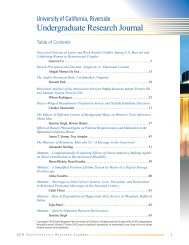2010 - Undergraduate Research, Scholarship and Creative Activity
2010 - Undergraduate Research, Scholarship and Creative Activity
2010 - Undergraduate Research, Scholarship and Creative Activity
Create successful ePaper yourself
Turn your PDF publications into a flip-book with our unique Google optimized e-Paper software.
availability have been demonstrated to alter<br />
microbial populations within meters. In this<br />
study, water availability did not alter peak CO 2<br />
efflux temperatures significantly (P>0.05) for<br />
any of the tested site. The relationship between<br />
organic matter content <strong>and</strong> soil CO 2 efflux is<br />
unclear as there is no clear pattern. The results<br />
suggest that the distribution of thermophilic<br />
bacteria is not confined to hyperthermic areas, as<br />
they are present in cooler climates <strong>and</strong> may<br />
become active under favorable conditions.<br />
Spenser’s Use of Structural Patterns in the<br />
L<strong>and</strong>scape of the The Faerie Queene<br />
Carlos Rivas, Art History/English<br />
Mentors: Heidi Brayman Hackel<br />
Department of English<br />
Conrad Rudolph<br />
Department of Art History<br />
Although Edmund Spenser is one of the most<br />
widely studied English renaissance poets, it was<br />
not until the twentieth century that scholars<br />
began to discover the numerological <strong>and</strong><br />
structural patterns present in his work.<br />
Moreover, little attention has been paid to the<br />
fantasy l<strong>and</strong>scape (Faeryl<strong>and</strong>) he created for his<br />
magnum opus, The Faerie Queene, a work<br />
which remains the longest poem in the English<br />
language. This project analyzes the l<strong>and</strong>scape<br />
<strong>and</strong> setting(s) of The Faerie Queene in terms of<br />
their structural patterns. After a careful charting<br />
<strong>and</strong> visual mapping of Spenser‘s l<strong>and</strong>scape, it is<br />
clear that Spenser consciously created a<br />
meticulously crafted l<strong>and</strong>scape for The Faerie<br />
Queene. Although early scholars of The Faerie<br />
Queene failed to find any patterns in the text,<br />
<strong>and</strong> criticized Spenser for a perceived lack of a<br />
unified structure in the poem, we know by<br />
looking at Spenser‘s other works (most notably<br />
Epithalamion) that he carefully constructed his<br />
poetry according to strict patterns that contain<br />
numerological, astrological, <strong>and</strong> religious<br />
significance. Keeping this in mind, it can be<br />
shown that there are undiscovered or unnoticed<br />
patterns in the l<strong>and</strong>scape <strong>and</strong> layout of The<br />
Faerie Queene, most notably that a symmetrical<br />
pattern exists in the l<strong>and</strong>scape. Such a pattern<br />
provides an itinerary for new readings of The<br />
previous interpretations. In conjunction with<br />
this project, a cartographical reconstruction of<br />
what Faeryl<strong>and</strong> looks has been created to<br />
visually demonstrate these patterns on a<br />
practical level.<br />
Physician Communication <strong>and</strong> Patient<br />
Outcome: A Meta-Analysis<br />
Himelda Rivera, Biology<br />
Contributor: Juliet Beni<br />
Mentor: Robin DiMatteo<br />
Department of Psychology<br />
Recent research has demonstrated the<br />
importance of health communication in<br />
predicting patient outcomes (DiMatteo, M.R.<br />
2001). The purpose of this work is to conduct a<br />
meta-analysis measuring the relationship<br />
between physicians‘ communication skills <strong>and</strong><br />
patients‘ satisfaction with medical care,<br />
objective <strong>and</strong> self-rated health, <strong>and</strong> psychological<br />
outcomes by comparison of their r effect<br />
size. In this study, a meta-analysis of over 200<br />
articles (published 1968-<strong>2010</strong>) collected from<br />
two literature databases (PsycINFO <strong>and</strong><br />
PubMed), was conducted. We extracted strong,<br />
generalizable r<strong>and</strong>om effects model statistics<br />
from which we carried out detailed moderator<br />
analysis by examining specific characteristics of<br />
the articles‘ diverse methodologies. From this<br />
analysis we have determined that there is a<br />
significant relationship between physicianpatient<br />
communication <strong>and</strong> patient satisfaction,<br />
patient objective <strong>and</strong> self-reported health, <strong>and</strong><br />
patient psychological outcome. Our preliminary<br />
moderator coding analyses have focused on<br />
health disparities in communications,<br />
specifically whether the magnitude of the effect<br />
between physician communication <strong>and</strong> patient<br />
outcome is influenced by factors such as<br />
ethnicity, nationality, gender, <strong>and</strong> language. We<br />
propose an in-depth analysis of this data <strong>and</strong><br />
report of the findings. Future research should<br />
focus on the causes of these disparities <strong>and</strong><br />
potential implications for training physicians in<br />
communication.<br />
Faerie Queene to emerge without disrupting<br />
Fourth Annual UCR Symposium for <strong>Undergraduate</strong> <strong>Research</strong>, <strong>Scholarship</strong> <strong>and</strong> <strong>Creative</strong> <strong>Activity</strong><br />
42














